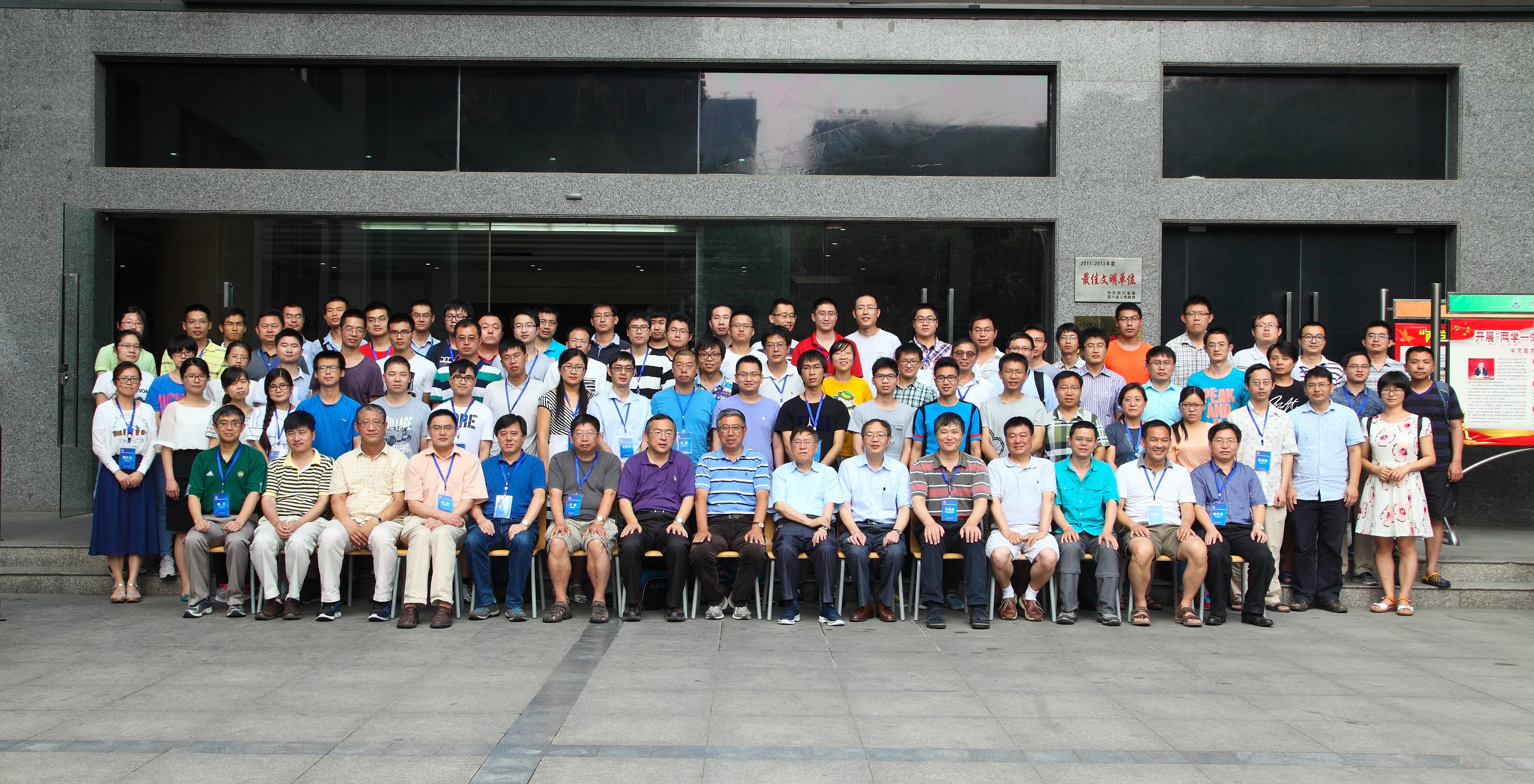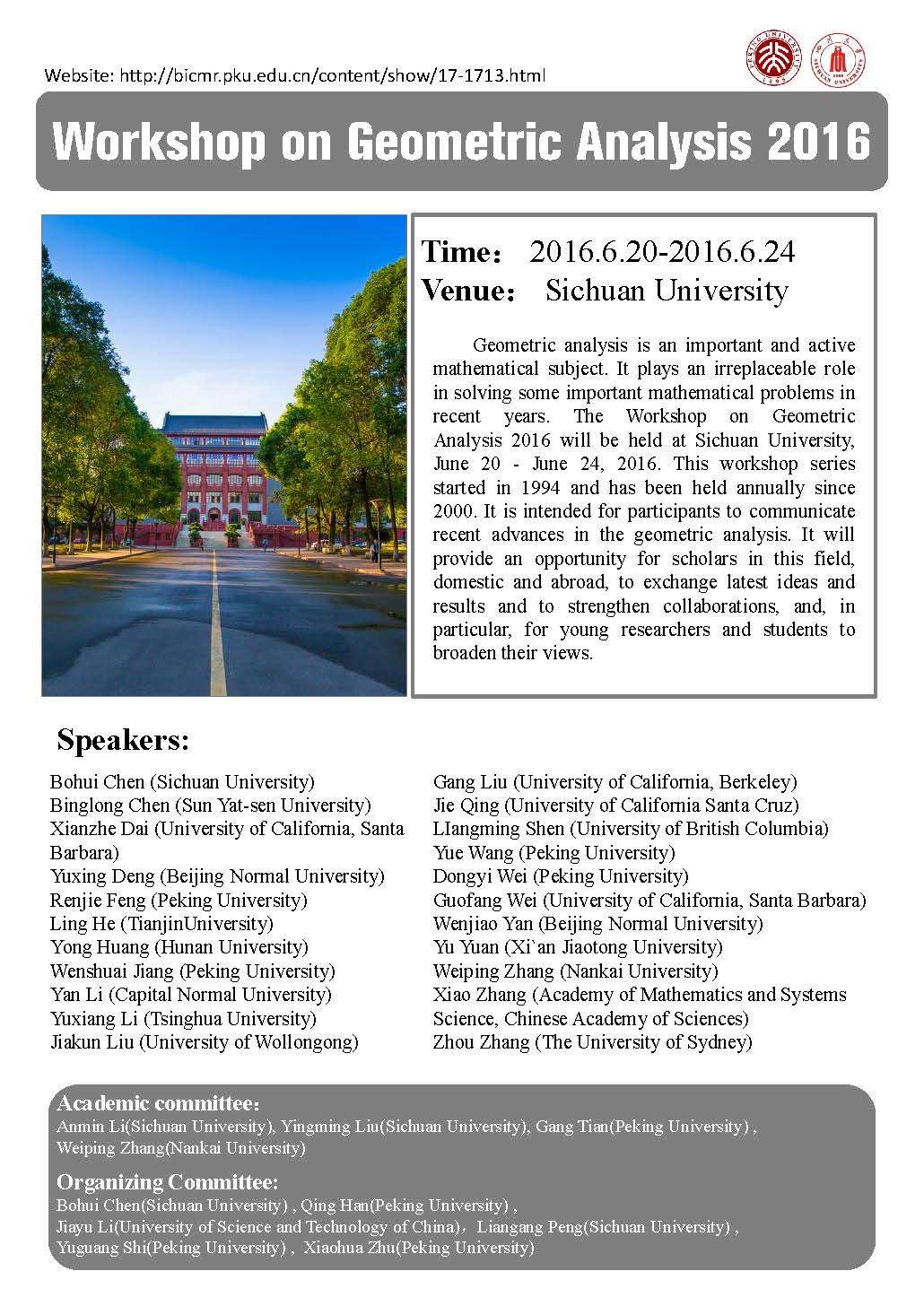Workshop on Geometric Analysis 2016
Time: June 20 - June 24, 2016
Venue: Sichuan University

Academic committee:
Anmin Li (Sichuan University)
Yingming Liu (Sichuan University)
Gang Tian (Peking University)
Weiping Zhang (Nankai University)
Organizing Committee:
Bohui Chen (Sichuan University)
Qing Han (Peking University)
Jiayu Li (University of Science and Technology of China)
Liangang Peng (Sichuan University)
Yuguang Shi (Peking University)
Xiaohua Zhu (Peking University)
Sponsors:
Sichuan University
Peking University
Contacts:
会前联系、报到 余萌 13810058754 admin2@math.pku.edu.cn
住宿、用餐、会场 刘莹 18628146693 yingliu0616@qq.com
日程表
June 20, Monday
天辰楼宾馆北楼三楼知明厅
|
9:00-9:10 |
Opening remarks |
|
9:20-10:10 |
Jie Qing (University of California Santa Cruz) |
|
10:40-11:30 |
Binglong Chen (Sun Yat-sen University) |
|
14:00-14:50 |
Yuxiang Li (Tsinghua University) |
|
15:00-15:50 |
Liangming Shen (University of British Columbia) |
|
16:10-17:00 |
Renjie Feng (Peking University) |
June 21, Tuesday
天辰楼宾馆北楼三楼知明厅
|
9:00-9:15 |
Photo session |
|
9:20-10:10 |
Weiping Zhang (Nankai University) |
|
10:40-11:30 |
Yu Yuan (Xi`an Jiaotong University) |
|
14:00-14:50 |
Yong Huang (Hunan University) |
|
15:00-15:30 |
Ling He (TianjinUniversity) |
|
15:50-16:40 |
Zhou Zhang (The University of Sydney) |
|
16:50-17:20 |
Yan Li (Capital Normal University) |
June 22, Wednesday
天辰楼宾馆北楼三楼知明厅
|
9:00-9:50 |
Xiao Zhang (Academy of Mathematics and Systems Science) |
|
10:00-10:30 |
Yue Wang (Peking University) |
|
10:50-11:40 |
Gang Liu (University of California, Berkeley) |
|
14:00-14:50 |
Jiakun Liu (University of Wollongong) |
|
15:00-15:50 |
Wenshuai Jiang (Peking University) |
|
16:10-17:00 |
Wenjiao Yan (Beijing Normal University) |
June 23, Thursday
天辰楼宾馆北楼三楼知明厅
|
9:00-9:50 |
Xianzhe Dai (University of California, Santa Barbara) |
|
10:00-10:30 |
Dongyi Wei (Peking University) |
|
10:50-11:40 |
Guofeng Wei (University of California, Santa Barbara) |
|
14:00-14:50 |
Bohui Chen (Sichuan University) |
|
15:00-15:50 |
Yuxing Deng (Beijing Normal University) |
学术报告题目与摘要
Correspondence for weighted blow-ups in orbifold Gromov-Witten theory
Bohui Chen (Sichuan University)
Abstract: Correspondence for blow-ups in smooth Gromov-Witten theory was established by Maulik-Pandharipande and Hu-Li-Ruan. We generalize such correspondence to orbifold case. As an application, we explain that the uniruledness is preserved by weighted blow-ups. This is a joint work with Chengyong Du and Jian-Xun Hu.
On stationary solutions to the Einstein field equations
Binglong Chen (Sun Yat-sen University)
Abstract:In this talk, we prove that any 4-d geodesically complete spacetime with a timelike Killing field satisfying the vacuum Einstein field equation with nonnegative cosmological constant is actually flat. We will also discuss the nonvacuum and higher dimensional case.
Partial geometric invariants
Xianzhe Dai (University of California, Santa Barbara)
Abstract: Many geometric invariants, such as the eta invariant and analytic torsion, can be given in terms of heat kernel. We introduce a notion of partial geometric invariants which can be used as an easy substitute for gluing formulas, especially when there is no known gluing formula (such as the holomorphic torsion) and talk about various applications.
Asymptotic geometry of positively curved steady Ricci solitons
Yuxing Deng (Beijing Normal University)
Abstract: Classification of positively curved steady Ricci solitons is an important problem in the study of Ricci flow. In this talk, we will analyze the asymptotic behavior of k-noncollapsed steady Ricci solitons. As an application, we prove that any k-noncollapsed steady Ricci soliton with positive biesctional curvature doesn't exist. Other application of the asymptotic geometry will also be discussed. This is a joint work with Prof. Xiaohua Zhu.
Random holomorphic fields on complex manifolds
Renjie Feng (Peking University)
Abstract: Random holomorphic sections of positive holomorphic line bundle on complex manifolds are natural generalization of random polynomials. In my talk, I will first define the random holomorphic fields and exhibit several well-known results. Then two of my results (joint with S. Zelditch) on the extrema of random fields will be given: the distribution of critical values and the mean value of the supremum of L^2-normalized fields. I will also talk about my recent results on the correlations of zeros and critical points of random analytic functions. I will also discuss several open problems.
The singular set of triholomorphic maps into quartic K3 surface
Ling He (TianjinUniversity)
Abstract:We prove that any weakly triholomorphic map from a compact hyperk\"{a}hler surface to an algebraic K3 surface defined by a homogeneous polynomial of degree 4 in $\mathbb{C}P^3$ has only isolated singularities. This is a joint work with Professor Jiayu Li.
Minkowski Problems of Convex bodies
Yong Huang (Hunan University)
Abstract: In this talk, I will report briefly on the devolopment of Minkowski problems of convex bodies during the past 120 years. In particular, I will also discuss a recent joint work with Erwin Lutwak, Deane Yang and Gaoyong Zhang.
L^2 curvature bounds on manifolds with bounded Ricci curvature
Wenshuai Jiang (Peking University)
Abstract: In this talk, we will discuss the L^2 curvature estimates on manifolds with bounded Ricci curvature and noncollapsing volume. Firstly, we will talk about the background, then we introduce the concept of neck region which appears everywhere in our proof. After that, we would sketch the whole proofs. At last, we would focus on the technical details and some new observations on neck region. This is joint work with Prof. Aaron Naber.
Bounding diameter of conical K\"{a}hler metric
Yan Li (Capital Normal University)
Abstract: In this paper we study the differential geometric and algebro-geometric properties of the noncollapsing limit in the conical continuity equation which generalize the La Nave-Tian-Zhang's results. Conical continuity equation can be viewed as elliptic version of conical K\"{a}hler Ricci flow. Firstly, the maximal time existence of conical continuity equation is essential. Secondly, if we focus on the noncollapsing case and assume that the maximal time is finite, then the limit behavior of $\omega_t$ can be obtained when $t$ tends to the maximal time. Thirdly, assuming that the maximal time is finite and applying Cheeger-Colding's theory, we investigate the structure of regular set in the limit space which is the limit of $(M,\omega_t)$ in the Gromov-Hausdorff topology. Furthermore, $L^{\infty}$ estimate and gradient estimate to holomorphic section imply that the limit space can be embedded to a projective space. Finally, we need to study the local properties of limit metric in order to prove the limit space homeomorphic to a normal variety.
Blowup behavior of Willmore Surfaces
Yuxiang Li (Tsinghua University)
Abstract: We will study the blowup behavior of a Willmore surface sequence with convergent conformal structure and bounded Willmore energy. First, we will prove such a sequence embedded in R^3 converges smoothly. Then we will use Ding-Tian's method to give a simple proof of the energy identity and prove a 'no-neck' property
Dirichlet problem for Monge-Amp\`ere type equations
Jiakun Liu (University of Wollongong)
Abstract: In this talk, we first recall some classical results of Dirichlet problem for standard Monge-Amp\`ere equations. Then we present a recent result on the global $C^{2,\alpha}$ estimates for solutions of the Dirichlet problem of Monge-Amp\`ere equations arising in optimal transportation, where the cost function satisfies a strong Ma-Trudinger-Wang condition and the inhomogeneous term is $C^\alpha$ and bounded away from zero and infinity. This is a joint work with Yong Huang and Feida Jiang.
Gromov-Hausdorff limit of Kahler manifolds with bisectional curvature lower bound
Gang Liu (University of California, Berkeley)
Abstract: Let M be a complete noncompact Kahler manifold with nonnegative bisectional curvature and maximal volume growth. We prove that M is diffeomorphic to the Euclidean space. Also, if the complex dimension is less than or equal to three, we prove M is biholomorphic to the complex Euclidean space. The proof is based on some analysis on Gromov-Hausdorff limit of Kahler manifolds with bisectional curvature lower bound.
Convexity and embeddness for hypersurfaces in hyperbolic space
Jie Qing (University of California Santa Cruz)
Abstract: This is a report on my joint work with Vincent Bonini and Shiguang Ma. Using the so-called horospherical metrics for immersed hypersurfaces with certain convexity in hyperbolic space, we present a proof for the conjecture (Alexander-Currier) that, except covering maps of equip-distance surfaces in hyperbolic 3-space, a complete, immersed, nonnegatively curved hypersurface in hyperbolic space is always embedded with at most two point boundary at infinity.
Unnormalized conical Kahler-Ricci flow
Liangming Shen (University of British Columbia)
Abstract: Given a conic metric along a simple normal crossing divisor, we consider the conical Kahler-Ricci flow which preserves the conic structure. We use approximation method to construct the solutions on the largest time interval. Then we establish high order estimates for such flow solution. Finally we briefly introduce some convergence results.
The minimal surface equation in the hyperbolic space over singular domains
Yue Wang (Peking University)
Abstract: We study the minimal surface equation in the hyperbolic space over singular domains. Under appropriate assumptions on the domains, we prove the existence of solutions of the Dirichlet problem and discuss the asymptotic behaviors of solutions near boundary.
Energy identity for approximate harmonic maps from surface to general targets
Dongyi Wei (Peking University)
Abstract: Let $u_n$ be a sequence of mappings from a closed Riemannian surface $M$ to a general Riemannian manifold $N\subset\R^k$. If $u_n$ satisfies $$ \sup_{n}\big(\|\nabla u_n\|_{L^2(M)}+\|\tau(u_n)\|_{L^{p}(M)}\big)\leq \Lambda\quad \text{for some}\,\,p>1, $$ where $\tau(u_n)$ is the tension field of $u_n$, then there hold the so called energy identity and neckless property during blowing up. This result is sharp by Parker's example, where the tension fields of the mappings from Riemannian surface are bounded in $L^1(M)$ but the energy identity fails.
Sharp Fundamental Gap Estimate on Convex Domains of Sphere
Guofang Wei (University of California, Santa Barbara)
Abstract: In their celebrated work, B. Andrews and J. Clutterbuck proved the fundamental gap (the difference between the first two eigenvalues) conjecture for convex domains in the Euclidean space and conjectured similar results holds for spaces with constant sectional curvature. We prove the conjecture for the sphere. Namely when $D$, the diameter of a convex domain in the unit $S^n$ sphere, is $\le \frac{\pi}{2}$, the gap is greater than the gap of the corresponding $1$-dim sphere model. We also prove the gap is $\ge 3\frac{\pi^2}{D^2}$ when $n \ge 3$, giving a sharp bound. As in B. Andrews and J. Clutterbuck's work, the key is to prove a super log-concavity of the first eigenfunction. This is a joint work with S. Seto and L. Wang.
Isoparametric foliation and the first eigenvalue problem
Wenjiao Yan (Beijing Normal University)
Abstract: S. T. Yau conjectured that the first eigenvalue of every closed minimal hypersurface in the unit sphere is just its dimension. We prove this conjecture for minimal isoparametric hypersurfaces. As for the focal submanifolds, which are minimal submanifolds in the unit sphere, we show that their first eigenvalues are also equal to their dimensions in the non-stable range. Moreover, we give some estimate on the other eigenvalues.
Special Lagrangian equations
Yu Yuan (Xi`an Jiaotong University)
Abstract: We survey some new and old, positive and negative results on a priori estimates, regularity, and rigidity for special Lagrangian equations with or without certain convexity. The "gradient" graphs of solutions are minimal or maximal Lagrangian submanifolds, respectively in Euclidean or pseudo-Euclidean spaces. In the latter pseudo-Euclidean setting, these equations are just Monge-Ampere equations. Development on the parabolic side (Lagrangian mean curvature flows) will also be mentioned.
On the Euler characteristic of affine manifolds
Weiping Zhang (Nankai University)
The positive energy theorem for asymptotically AdS spacetimes
Xiao Zhang (Academy of Mathematics and Systems Science, Chinese Academy of Sciences)
Abstract: The positive energy theorem plays a fundamental role in general relativity. It was first proved by Schoen-Yau in 1979 using the method of geometric analysis in the case of zero cosmological constant, where initial data sets are asymptotically flat. Later Witten used spin geometry to give another proof. When the cosmological constant is negative and spacetimes are asymptotically AdS, initial data sets are asymptotically hyperbolic. In 1989, Min-Oo extended Witten’s method to asymptotically hyperbolic spin manifolds and proved rigidity of hyperbolic spaces. Min-Oo’s method was lately used by several authors to provide the complete and rigorous proof of the positive energy theorem for asymptotically AdS spacetimes in special cases. In this talk, we will give a short review of the topic. In particular, we will discuss the recent proof by Wang, Xie and the author on the positive energy theorem in the most general case as well as the finding of the invariant mass for asymptotically AdS spacetimes.
Flow Limit for the Kahler-Ricci Flow
Zhou Zhang (The University of Sydney)
Abstract: motivated by a question of Tian's, we consider the
existence of flow limit for the Kahler-Ricci flow in the sense of current. The
answer is complete and affirmative for the case of finite time singularity, and
the infinite time case is significantly different.



